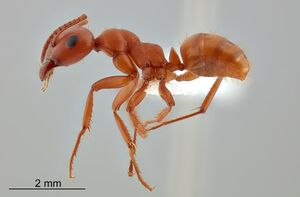Formica curiosa
| Formica curiosa | |
|---|---|

| |
| Scientific classification | |
| Kingdom: | Animalia |
| Phylum: | Arthropoda |
| Class: | Insecta |
| Order: | Hymenoptera |
| Family: | Formicidae |
| Subfamily: | Formicinae |
| Tribe: | Formicini |
| Genus: | Formica |
| Species: | F. curiosa |
| Binomial name | |
| Formica curiosa Creighton, 1935 | |
| Synonyms | |
| |
This species is a member of a group of Formica species that were formerly placed in the subgenus Raptiformica. All species are facultative slavemakers, i.e., species which usually or often have slaves but can get along without them. The colony-founding female forces her way into a small colony of another species of Formica, somehow gets rid of its queen and workers and appropriates its nest and brood. The workers emerging from this brood accept the intruding queen as their own. The enslaved species belong to the Formica neogagates, fusca, and pallidefulva species groups. When the workers of the slave-making species have become numerous enough, they start raiding for more slaves.
Identification
Distribution
Montana to Washington and Oregon, south to northern Nevada, north into British Columbia.
Latitudinal Distribution Pattern
Latitudinal Range: 48.3° to 43.5408°.
| North Temperate |
North Subtropical |
Tropical | South Subtropical |
South Temperate |
- Source: AntMaps
Distribution based on Regional Taxon Lists
Nearctic Region: Canada, United States (type locality).
Distribution based on AntMaps
Distribution based on AntWeb specimens
Check data from AntWeb
Countries Occupied
| Number of countries occupied by this species based on AntWiki Regional Taxon Lists. In general, fewer countries occupied indicates a narrower range, while more countries indicates a more widespread species. |

|
Estimated Abundance
| Relative abundance based on number of AntMaps records per species (this species within the purple bar). Fewer records (to the left) indicates a less abundant/encountered species while more records (to the right) indicates more abundant/encountered species. |

|
Biology
Nevada, Wheeler and Wheeler (1986) - We have 2 records from 2 localities near the northern border of the state, based on concolorous strays. Both were in the Sarcobatus Subclimax of the Cool Desert.
Association with Other Organisms
 Explore: Show all Associate data or Search these data. See also a list of all data tables or learn how data is managed.
Explore: Show all Associate data or Search these data. See also a list of all data tables or learn how data is managed.
- This species is a host for the fungus Laboulbenia formicarum (a parasite) (Quevillon, 2018) (encounter mode primary; direct transmission; transmission within nest).
- This species is a host for the fungus Laboulbenia formicarum (a pathogen) (Espadaler & Santamaria, 2012).
Castes

| |
| . | |
Nomenclature
The following information is derived from Barry Bolton's Online Catalogue of the Ants of the World.
- curiosa. Formica curiosa Creighton, 1935: 5, fig. 2 (w.q.) U.S.A. Senior synonym of parcipappa: Snelling, R.R. 1969b: 194.
- parcipappa. Formica parcipappa Cole, 1947: 616 (w.) U.S.A. Combination in F. (Serviformica): Buren, 1968a: 32. Junior synonym of curiosa: Snelling, R.R. 1969b: 194.
Description
References
- Creighton, W. S. 1935. Two new species of Formica from western United States. American Museum Novitates 773: 1-8. (page 5, fig. 2 worker, queen described)
- Espadaler, X., Santamaria, S. 2012. Ecto- and Endoparasitic Fungi on Ants from the Holarctic Region. Psyche Article ID 168478, 10 pages (doi:10.1155/2012/168478).
- Snelling, R. R. 1969c. Notes on the systematics and dulosis of some western species of Formica, subgenus Raptiformica (Hymenoptera: Formicidae). Proc. Entomol. Soc. Wash. 71: 194-197 (page 194, Senior synonym of parcipappa)
- Wheeler, G. C. and J. Wheeler. 1986. The ants of Nevada. Natural History Museum of Los Angeles County, Los Angeles.
References based on Global Ant Biodiversity Informatics
- Buren W. F. 1968. Some fundamental taxonomic problems in Formica (Hymenoptera: Formicidae). J. Georgia Entomol. Soc. 3: 25-40
- Longino, J.T. 2010. Personal Communication. Longino Collection Database
- Snelling R. R. 1969. Notes on the systematics and dulosis of some western species of Formica, subgenus Raptiformica (Hymenoptera: Formicidae). Proceedings of the Entomological Society of Washington 71: 194-197.
- Wheeler G. C., and J. Wheeler. 1986. The ants of Nevada. Los Angeles: Natural History Museum of Los Angeles County, vii + 138 pp.
- Wheeler, G.C. and J. Wheeler. 1988. A checklist of the ants of Montana. Psyche 95:101-114
- Wilson E. O., and W. L. Brown, Jr. 1955. Revisionary notes on the sanguinea and neogagates groups of the ant genus Formica. Psyche (Cambridge) 62: 108-129.

